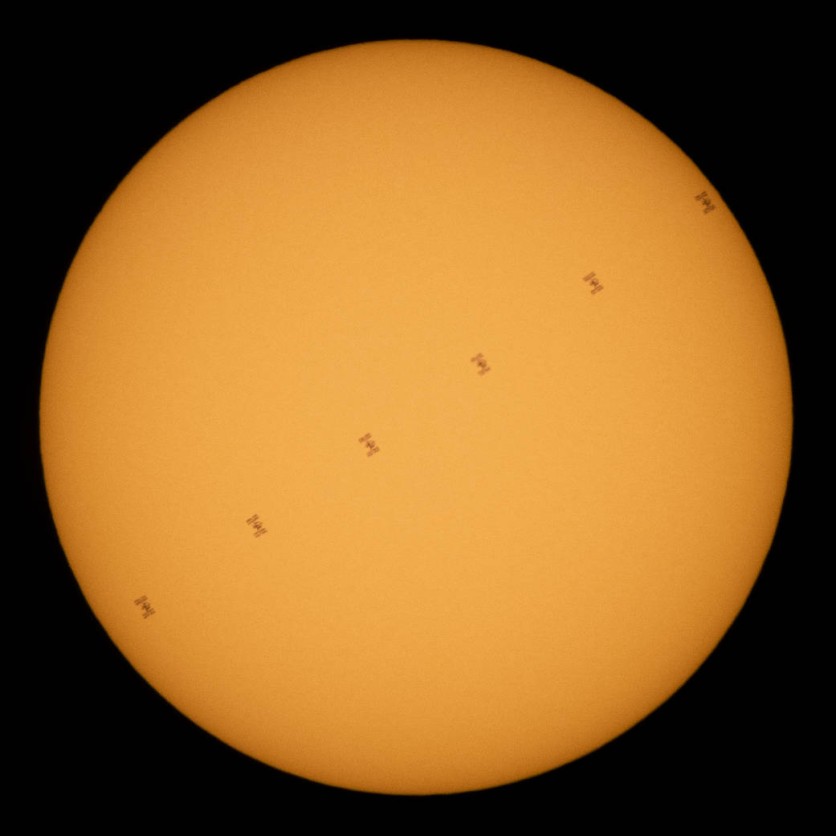A breathtaking photograph depicts the International Space Station (ISS) passing between the Earth and the sun. According to CNET, the incredible composite shot was taken by photographer Joel Kowsky of The National Aeronautics and Space Administration (NASA). If you look closely at the image below, you can see the tiny ISS against the sun's warm, yellow face.
The astronauts aboard the ISS also snapped a few Crew Dragon photos during their spacewalk as a possible return date was revealed.

Although the ISS is closer to the Earth than the Sun, the orbiting laboratory is still dwarfed in the background against the immense sun's surface.
The now-viral photo shows the ISS's position in its orbit as Kowsky snapped his pictures around 1:15 p.m. U.S. Eastern Daylight Time. The transit lasted about 0.54 seconds and was shot while aiming his camera at 10 frames per second.
How to snap the ISS traveling across the Sun--NASA
Kowsky says that many websites help determine when the ISS is going to transit the sun. Still, weather and timing are typically the key problems for shooting clear pictures.
"With [a minimal] path of visibility along the ground, having clear weather at the identified location is one of the most limiting factors in [capturing] a transit," said Kowsky, who had weather ruin a recent attempt.
Even when photographing the sun, proper protective equipment is required because looking directly at it can harm your eyes. The space agency has previously released images of the ISS Crossing the sun, including during the August 2017 total solar eclipse. Recent transit pictures also revealed a lack of sunspots. The sun is approaching a time of low solar activity known as the solar minimum.
SpaceX photos
NASA astronaut Chris Cassidy tweeted a spectacular shot of SpaceX's Crew Dragon spacecraft docked with the International Space Station (ISS).
The capsule looks tiny alongside the massive space station. In reality, its interior is big enough for a person to do anything similar to a somersault.
Astronauts cherish every opportunity to be part of a #spacewalk, and yesterday was no different. @AstroBehnken and I completed the first step in updating the external batteries which are connected to the outboard starboard solar arrays on @Space_Station. pic.twitter.com/hsE0bJld5t — Chris Cassidy (@Astro_SEAL) June 27, 2020
Cassidy recorded the image with fellow astronaut Bob Behnken during the spacewalk. The trip included constant work to update the space station's power systems, exchanging old nickel-hydrogen batteries for new lithium-ion batteries.
The batteries store power from the leading solar arrays at the station. The new ones would provide the orbital outpost with an increased and more effective power range. Cassidy later tweeted a few other shots from the spacewalk, one being a "space selfie" and another being taken shortly after the pair returned to the ISS 's interior.
NASA has declared the six-hour spacewalk a success and is now planning another Wednesday, July 1, to see the work completed.
SpaceX Crew Dragon
The spacecraft of SpaceX launched its first crew on May 30, carrying Bob Behnken and Doug Hurley as part of the Demo-2 flight to the ISS.
NASA said last week that it is currently planning the Crew Dragon return, along with Behnken and Hurley, no sooner than August 2. The trip home will follow the completion of the spacecraft's further testing during its docked period at the space station.
This includes a measure of habitability scheduled for July 4. It will consist of four astronauts from the ISS joining the capsule. They will be performing everyday tasks and emergency procedures and will also be learning how it will work with more astronauts onboard during future crew missions. Upcoming space tourism trips may be seen as a potential NASA mission in the future.




